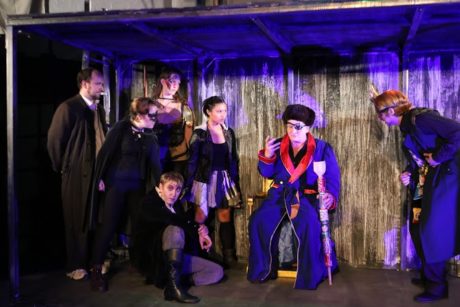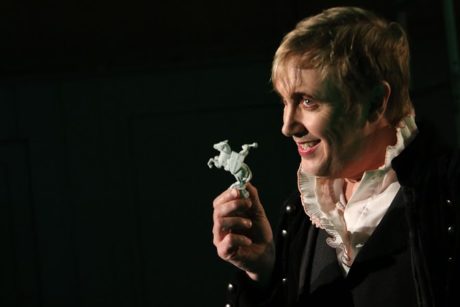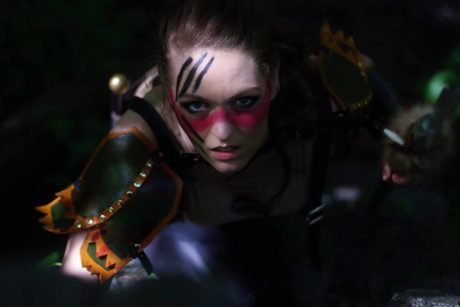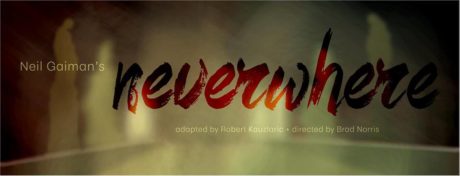To close out an already impressive second season, Cohesion Theatre Company has mounted its most ambitious show yet – the Baltimore premiere of Neil Gaiman’s Neverwhere, adapted for the stage by Robert Kauzlaric. I should admit this up front: I love Neil Gaiman. He is my favorite author and Neverwhere is my favorite of his books.

I’d been looking forward to this production for the six months since I learned it was happening. As opening night approached, I started to worry that my expectations were a wee bit high. In fact, to paraphrase the play, my expectations were a little bit high in the same way rats are a little bit covered in fur. Despite my fangirl preconceptions, Cohesion’s Neverwhere was even better than I’d hoped.
Neverwhere tells the story of Richard Mayhew, a regular guy who, through an act of compassion, lands himself in the middle of a dangerous quest in a world he never knew existed. London Below coexists with the workaday world Richard knows (London Above) and seems familiar, but is a place of magic, savagery, and darkness. In London Below, Richard travels with Door, a girl who possesses a special power, as she searches for answers in the gritty underbelly of the city. They encounter helpful rats, ruthless mercenaries, an Angel, a Marquis, an Earl, and a beast – all the while, trying to evade a pair of murderous villains intent on their destruction.
Joseph Coracle made a terrific Richard Mayhew. Coracle’s nuanced performance showed that while his character was tentative at the start of his journey, he possessed a strength and disarming humility that got him through the worst of ordeals. I was also delighted with Coracle’s believable and consistent accent for the Scottish Mr. Mayhew. There are few things as painful as poorly done Scottish brogue.
Cori Dioquino was charming as the gifted Lady Door. She deftly alternated between the exuberance that comes with her character’s young age and the suffering she felt from the grim circumstance that made her have to take on an adult role for her family. My favorite Door moment was when, in a moment of freedom from her dark burden, she gleefully made make-believe snow angels on the ground. Dioquino’s giddiness was infectious.

As the Marquis de Carabas, Jonas David Grey was a study in swagger. The Marquis is something of an antihero with his pilfering hands and condescending manner, but I couldn’t help but like him. Grey adeptly brought forth his character’s charm and favored the audience with glimpses of his quirky nobility. The Marquis may be a scoundrel, but he is a scoundrel with a moral code. I was also sincerely impressed with the apparent ease with which Grey rode standing atop 10-foot-tall set pieces as they sped across the performance space, hot stage lights a mere inch above his head. If it made him uncomfortable, I saw no hint of it. It just served to make The Marquis de Carabas appear even more swashbucklingly confident.
Cassandra Dutt’s performance was a pleasure to watch. She portrayed two incredibly dissimilar characters, creating a juxtaposition that highlighted her acting range. As Sylvia, the office manager in the London Above firm where Richard worked as an investment analyst, Dutt was prim and proper. Her speech was clipped and professional; she was all about business. As Hunter, the fierce predator who killed the Alligator King in the sewers of New York and numerous other beasts of urban legend, Dutt was mysterious and deadly. She had a passionate bloodlust to become the greatest warrior in the world. Working as Door’s bodyguard, her Slavic-accented speech was serious and no-nonsense as she guided her charges toward their goal.
Because it’s a dubious honor, I will clarify that I mean it as a great compliment when I say that Mr. Croup and Mr. Vandemar felt like the roles that Matthew Payne and Bobby Hennenberg were born to play. I’ve seen both of these actors perform before and while they were always good, there seems to be something about these characters that made these men shine. Their performances as the torture-loving, blood-thirsty agents of misery were absolutely brilliant.
Payne’s portrayal of the grandiloquent Mr. Croup was magnificent. His voice was strong and dripping with an oddly sophisticated brand of evil. His facial expressions and gestures, his tony duds and particular way of moving – all of it conspired to make him a picture of malevolence. Polite, well-spoken malevolence. Hennenberg’s Mr. Vandemar, on the other hand, was brute force incarnate. He was perhaps a bit slower than Mr. Croup, and was very plain-spoken in his working-class London accent about his insatiable desire for destruction. His childlike description of using a human head like a hand puppet was chilling. Hennenberg’s use of his strength, physicality and voice – especially the little laugh he made when inflicting pain – was spine-tinglingly creepy.
Cohesion Co-Founder Brad Norris, Director and Sound Designer for this show, did a great job bringing London Below to life. His passion for this project is obvious in every disturbing detail and his enthusiasm led him to elicit outstanding performances from a talented and well-selected cast. I also loved his music choices. I found myself smiling every time the sinister Mr. Croup received a phone call, his ring tone being set to The Clash’s “London Calling.”
Norris gathered a creative dream team for this production. Kel Millionie (Set/Lighting Designer), Sam Kuczynski (Properties Designer), and Haley Horton (Scenic Painter) transformed the theater space at United Evangelical Church into an expansive world. Two cleverly designed, two-story set pieces served as train cars and skyscrapers, houses and a labyrinth. It was an all hands on deck operation to move these large pieces around the stage over and over, but the effect was fantastic and presented the audience with a sense of the ever-shifting world Richard Mayhew was facing.
Millionie’s lighting design was expertly crafted. More than simply signaling changes in focus or scene, the lights conveyed substantive information about the action. I especially liked the way the lighting showed Richard’s departure from the real world into fitful, nightmarish sleep. In conjunction with Norris’ sound choices, the lights created an otherworldly atmosphere that perfectly complimented the many locations and moods of London Below.

Likewise, the work of Costume Designer Sam Callanta and Hair and Makeup Designer Emily Jewett was spot-on. Costuming the cast in their primary roles was a task in itself, but with most actors playing multiple parts, Callanta really rose to the challenge. Notable sartorial choices included the devilish pair of Messrs. Croup and Vandemar; the stylish Fop with No Name; the regal-looking trickster Marquis de Carabas, and the fierce Hunter. Jewett’s hair and makeup design talent was particularly well exhibited on these characters, from the sunken-eyed pallor of the assassins to the warrior markings of the Hunter. And when people got injured or bloodied, you really knew it.
Fight Choreographer Jonathan Ezra Rubin had his hands full with all the injuring and bloodying in this show. Cohesion actors are known for their prowess in fight scenes, but Rubin took them to the next level. The fights with blades and fists were all quite good, but it was the work with the quarterstaff that I enjoyed the most. The precision timing of jumps and strikes evidenced careful, skilled planning and weeks of practice.
I do wish the during the scene when the questers first attend the floating market, I would have been able to hear all the dialog. I absolutely loved the market. The hullaballoo of the hawkers and all the different activities going on at once felt just like night markets I’ve visited in far-flung places around the globe. It was awesome except that for a portion of that scene, The Marquis de Carabas and Old Bailey were having a conversation. From my seat at the end of the front row, I couldn’t make out what they were saying. Because I know the story so well, I know that the bit of information gained by their exchange is not essential to the plot and you get most of it in subsequent scenes anyway, but if I were new to the story, it probably would have been pretty frustrating.
With well-executed technical complexities and truly superb acting, Cohesion Theatre Company’s production of Neverwhere exceeded my very high expectations. Start your summer right by going to see this company close out their successful second season with this fantastic show. Cohesion took a big risk putting up this bold, ambitious show and it really paid off. Seeing Neverwhere at Cohesion Theatre Company was one of the highlights of my 2015/16 theatre season.
Running Time: Approximately three hours, including a 15-minute intermission.
Neverwhere plays through June 19, 2016 at Cohesion Theatre, performing at United Evangelical Church – 3200 Dillon Street, in Baltimore, MD. For tickets, purchase them at the door or online. Tickets can be purchased at the box office or online.
RATING:





